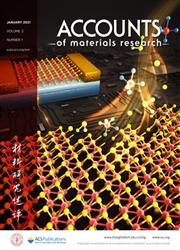Lattice Energy Reservoir in Metal Halide Perovskites
IF 14.7
Q1 CHEMISTRY, MULTIDISCIPLINARY
引用次数: 0


金属卤化物钙钛矿中的晶格能库
图1所示。卤化物钙钛矿中晶格能量库作为动态纳米畴的方案。蓝色LER:能量储存前,红色LER:声子-晶格耦合能量积累,在周围建立更高的势能。(ph-phonon)(a) LER抑制热载体冷却方案。具有不同晶格应变的同结抑制了向周围晶格的热输运,进而诱导声光声子上转换。(b)钙钛矿中的声子动力学。标记声子动力学过程为:(1)Fröhlich载流子主要在卤化铅框架上相互作用;(2)卤化铅LO声子的弛豫,声子-声子散射可以激发有机亚晶格;(3)声子与声子之间的非谐波散射阻碍了声子的传播;(4)声子上转换;(5)载体再加热。(3)经ref(3)许可转载。版权所有2017作者。图3。以秒为时间尺度连续照明卤化钙钛矿的PL增强。MAPbI3纳米板在405 nm 200 mW/cm2连续光照下的发光强度(a)和发光衰减曲线(b)。图4。由LER诱导的子隙载流子上转换光增亮原理图。(a)照明前无LER效应,(c)载流子寿命短。(b)在光照下,热ler形成(红色区域),子隙载流子可以上转换回CB, (d)导致载流子寿命显著延长。(TS:俘获/亚稳态,ph:声子,e:电子。)图5。在照明下由热发光二极管驱动的亚隙电子上转换示意图。图6。(a) MAPbBr3单晶在405 nm激发、350 mW/cm2影响下的随时间变化的PL光谱。(b)在405 nm连续激发下,MAPbBr3单粒荧光间歇性随时间的变化。温晓明博士于2007年获得浙江大学学士和硕士学位,并于澳大利亚斯威本大学获得博士学位。1989年至2003年,任云南大学教授、副系主任。曾在墨尔本大学、新南威尔士大学、澳大利亚斯威本科技大学和台湾中央研究院从事材料的超快光谱和光物理研究。他目前是RMIT大学的高级研究员和主题负责人,专注于钙钛矿的光物理和光伏应用。贾宝华教授获英国斯威本大学博士学位。她是澳大利亚科技科学与技术学院(FTSE)院士,澳大利亚研究理事会未来研究员,澳大利亚皇家墨尔本理工大学原子材料和纳米制造中心(CAN)创始主任。贾教授担任《NPJ纳米光子学》杂志主编。贾教授是中国科学院光学学会院士、中国科学院材料、矿产与采矿研究所院士。贾教授的研究主要集中在新型纳米结构和纳米材料的设计和光学特性、制造以及光能的有效转换和存储。作者感谢澳大利亚研究委员会通过未来奖学金(FT210100806),发现项目(DP220100603),卓越中心计划(CE230100006)和Linkage (LP240100504, LE250100078)以及澳大利亚可再生能源机构(ARENA TM021)提供的财政支持。本文引用了35个其他出版物。这篇文章尚未被其他出版物引用。
本文章由计算机程序翻译,如有差异,请以英文原文为准。
求助全文
约1分钟内获得全文
求助全文

 求助内容:
求助内容: 应助结果提醒方式:
应助结果提醒方式:


